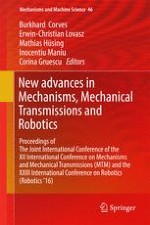This volume presents the proceedings of the Joint International Conference of the XII International Conference on Mechanisms and Mechanical Transmissions (MTM) and the XXIII International Conference on Robotics (Robotics ’16), that was held in Aachen, Germany, October 26th-27th, 2016. It contains applications of mechanisms and transmissions in several modern technical fields such as mechatronics, biomechanics, machines, micromachines, robotics and apparatus. In connection with these fields, the work combines the theoretical results with experimental testing. The book presents reviewed papers developed by researchers specialized in mechanisms analysis and synthesis, dynamics of mechanisms and machines, mechanical transmissions, biomechanics, precision mechanics, mechatronics, micromechanisms and microactuators, computational and experimental methods, CAD in mechanism and machine design, mechanical design of robot architecture, parallel robots, mobile robots, micro and nano robots, sensors and actuators in robotics, intelligent control systems, biomedical engineering, teleoperation, haptics, and virtual reality.
